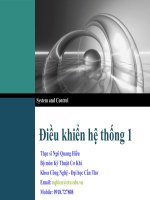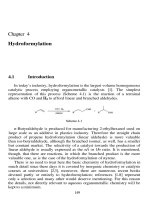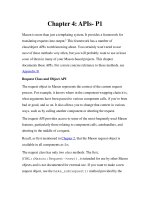Chapter 4: Digital communications pptx
Bạn đang xem bản rút gọn của tài liệu. Xem và tải ngay bản đầy đủ của tài liệu tại đây (1.57 MB, 75 trang )
Chapter 4: Digital communications
Lecturer: M.Eng. P.T.A. Quang
Outline
Pulse code modulation
E1 systems
T1 systems
Pulse Code Modulation (PCM)
PCM consists of three steps to digitize an
analog signal:
1. Sampling
2. Quantization
3. Binary encoding
Before we sample, we have to filter the signal to
limit the maximum frequency of the signal as it
affects the sampling rate.
Filtering should ensure that we do not distort
the signal, ie remove high frequency
components that affect the signal shape.
PCM
4.4
Components of PCM encoder
Sampling
4.5
Analog signal is sampled every T
S
secs.
T
s
is referred to as the sampling interval.
f
s
= 1/T
s
is called the sampling rate or sampling
frequency.
There are 3 sampling methods:
Ideal - an impulse at each sampling instant
Natural - a pulse of short width with varying amplitude
Flattop - sample and hold, like natural but with single
amplitude value
The process is referred to as pulse amplitude
modulation PAM and the outcome is a signal with
analog (non integer) values
Sampling
Three different sampling methods for PCM
4.7
According to the Nyquist theorem, the
sampling rate must be
at least 2 times the highest frequency
contained in the signal.
Note
Sampling
Nyquist sampling rate for low-pass and bandpass signals
4.9
Recovery of a sampled sine wave for different sampling rates
4.10
An example related to Example 4.7 is the seemingly
backward rotation of the wheels of a forward-moving car
in a movie. This can be explained by under-sampling. A
movie is filmed at 24 frames per second. If a wheel is
rotating more than 12 times per second, the under-
sampling creates the impression of a backward rotation.
Example
4.11
Telephone companies digitize voice by assuming a
maximum frequency of 4000 Hz. The sampling rate
therefore is 8000 samples per second.
Example
4.12
A complex low-pass signal has a bandwidth of 200 kHz.
What is the minimum sampling rate for this signal?
Solution
The bandwidth of a low-pass signal is between 0 and f,
where f is the maximum frequency in the signal.
Therefore, we can sample this signal at 2 times the
highest frequency (200 kHz). The sampling rate is
therefore 400,000 samples per second.
Example
4.13
A complex bandpass signal has a bandwidth of 200 kHz.
What is the minimum sampling rate for this signal?
Solution
We cannot find the minimum sampling rate in this case
because we do not know where the bandwidth starts or
ends. We do not know the maximum frequency in the
signal.
Example 4.11
Quantization
Sampling results is a serie of pulses of varying
amplitude values ranging between two limits: a min
and a max.
The amplitude values are infinite between the two
limits.
We need to map the infinite amplitude values onto
a finite set of known values.
This is achieved by dividing the distance between
min and max into L zones, each of height
= (max - min)/L
Quantization Levels
The midpoint of each zone is assigned a value from 0
to L-1 (resulting in L values)
Each sample falling in a zone is then approximated to
the value of the midpoint.
Quantization Zones
Assume we have a voltage signal with amplitutes
V
min
=-20V and V
max
=+20V.
We want to use L=8 quantization levels.
Zone width = (20 - -20)/8 = 5
The 8 zones are: -20 to -15, -15 to -10, -10 to -5, -5 to
0, 0 to +5, +5 to +10, +10 to +15, +15 to +20
The midpoints are: -17.5, -12.5, -7.5, -2.5, 2.5, 7.5, 12.5,
17.5
Assigning Codes to Zones
Each zone is then assigned a binary code.
The number of bits required to encode the zones,
or the number of bits per sample as it is
commonly referred to, is obtained as follows:
n
b
= log
2
L
Given our example, n
b
= 3
The 8 zone (or level) codes are therefore: 000,
001, 010, 011, 100, 101, 110, and 111
Assigning codes to zones:
000 will refer to zone -20 to -15
001 to zone -15 to -10, etc.
Quantization and encoding of a sampled signal
Quantization Error
When a signal is quantized, we introduce an error
- the coded signal is an approximation of the
actual amplitude value.
The difference between actual and coded value
(midpoint) is referred to as the quantization error.
The more zones, the smaller which results in
smaller errors.
BUT, the more zones the more bits required to
encode the samples higher bit rate
Quantization Error and SN
Q
R
Signals with lower amplitude values will suffer
more from quantization error as the error range:
/2, is fixed for all signal levels.
Non linear quantization is used to alleviate this
problem. Goal is to keep SN
Q
R fixed for all sample
values.
Two approaches:
The quantization levels follow a logarithmic curve. Smaller
’s at lower amplitudes and larger ’s at higher amplitudes.
Companding: The sample values are compressed at the
sender into logarithmic zones, and then expanded at the
receiver. The zones are fixed in height.
Quantization Error and SN
Q
R
Bit rate and bandwidth
requirements of PCM
4.22
The bit rate of a PCM signal can be calculated form the
number of bits per sample x the sampling rate
Bit rate = n
b
x f
s
The bandwidth required to transmit this signal depends on
the type of line encoding used. Refer to previous section
for discussion and formulas.
A digitized signal will always need more bandwidth than
the original analog signal. Price we pay for robustness and
other features of digital transmission.
4.23
We want to digitize the human voice. What is the bit rate,
assuming 8 bits per sample?
Solution
The human voice normally contains frequencies from 0
to 4000 Hz. So the sampling rate and bit rate are
calculated as follows:
Example
PCM Decoder
4.24
To recover an analog signal from a digitized signal
we follow the following steps:
We use a hold circuit that holds the amplitude value of a
pulse till the next pulse arrives.
We pass this signal through a low pass filter with a cutoff
frequency that is equal to the highest frequency in the
pre-sampled signal.
The higher the value of L, the less distorted a
signal is recovered.
Components of a PCM decoder









